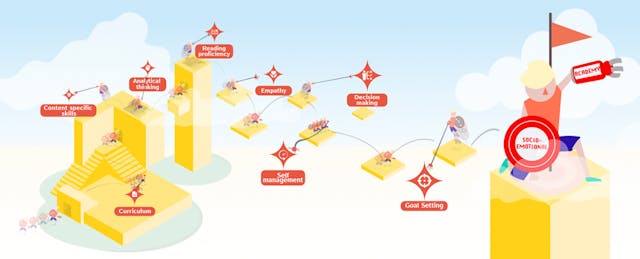“Mister, why do we have to do this? I’d honestly rather work on math right now. Or anything else.” This was a common refrain in advisory class. I was a certified high school math teacher, but like so many of my peers, I also taught advisory—working with students to develop their social skills and help them explore college and career options.
Being in a New York City alternative high school serving at-risk kids, my students were academically behind and at risk of getting sucked into the school-to-prison pipeline. It was vital they graduated, but a diploma doesn’t guarantee students the social emotional learning (SEL) skills needed to be informed citizens and productive members of society. In this country, SEL is often put on the backburner and siloed off in classes like advisory or guidance. Although advisory was required for my students to accumulate elective credits and meet graduation requirements, I wasn’t provided thoughtful or engaging curriculum. I rarely felt underprepared teaching math, but in advisory I perfected the art of improvising. It took a couple of years for me to finally figure out that teaching social skills in isolation is absolutely ridiculous.
According to the Collaborative for Academic, Social, and Emotional Learning, (CASEL), social emotional learning is “the process through which children and adultsacquire and effectively apply the knowledge, attitudes, and skills necessary to understand and manage emotions, set and achieve positive goals, feel and show empathy for others, establish and maintain positive relationships, and make responsible decisions.” CASEL defines these in terms of specific competencies that can be assessed and mastered: self-awareness, self-management, social awareness, relationship skills, and responsible decision making.
I can say with confidence my students didn’t learn anything in advisory in my first two years teaching it. I had no idea what I was doing and I was never paired with a veteran teacher. In my third year, I decided to write my own advisory curriculum, grounded in debate and civil discourse. I wanted my students to learn how to reason effectively: I loved hanging out with them during lunch and I was getting `irritated hearing them argue with faulty logic. That year, my students would learn how to listen actively, communicate clearly, and control outbursts. They chose to debate over issues resonating with them the most: police reform, stop and frisk, housing segregation, and gentrification. Near the end of the semester, we held a formal debate. It was fantastic, causing me to have a “this is why I teach” moment and restoring my confidence in my curriculum and the class.
But when it came time for my advisory students to defend their logic in Algebra, the skills just did not transfer. “This isn’t advisory Mister, this is MATH AND I’M TRYING TO TELL YOU MY ANSWER!” Their SEL skills remained firmly in advisory class.
In “the real world” as teachers say, challenges are complex. You’re never just solving a math problem. You’re communicating, collaborating, managing yourself, the list goes on. Life is interdisciplinary, and while our education system has finally started to acknowledge this (e.g. STEAM, the CCLS ELA standards, etc.), we’re still compartmentalizing what makes us human: social emotional learning. The head and the heart are connected, and our schools, curriculum, and education technology should reflect this.
At Kiddom, my classroom experience with at-risk youth has proved invaluable in helping us build a platform that connects content, curriculum, and analytics. Being standards-based, we support CASEL’s SEL competencies and we encourage our teachers to track them in tandem with academic standards. Our content integrations help teachers personalize learning and provide students with the ability to self-advocate and manage their own learning, two key SEL competencies.
Here’s how it might work for an English teacher: Imagine you’ve assigned students a persuasive essay and provided them with a rubric communicating academic expectations. With Kiddom, you can append SEL competencies directly into the same rubric, and track those skills in one place. If you want your students to manage themselves (e.g. complete and submit the assignment on time), you can add a self-management rubric row. Thoughtfully mixing SEL with academics ensures SEL isn’t being taught in isolation. If you want a framework for this or just more examples, download the free guide we co-authored on integrating SEL into K-12 academic curriculum.
Kiddom is just one education technology company. Teachers need more education technology companies thoughtfully creating and providing SEL content and services. And they need schools to provide the professional development they need to learn how to effectively weave SEL into curriculum. As technology gets smarter and continues to empower us, the future does not depend on all students learning how to code or take AP calculus. Rather, the future will lie in learning how to solve complex problems with empathy and sound decision-making because social emotional learning transcends the classroom.
Resources for Teachers and Administrators
This resource list is excerpted from the guide we wrote with SEL teachers, Social Emotional Learning 101: Bridging SEL with Academics.
- The Social and Emotional Learning School
- The Greater Good: How to Integrate SEL into CCLS
- NPR: Why Emotional Literacy May Be As Important As Learning the ABCs
- Edutopia: The History of Social Emotional Learning
- How Education Technology Can Help Foster SEL
- The Atlantic: Get to Know Your Teachers, Kids
- The New York Times: To Help Students Learn, Engage the Emotions



